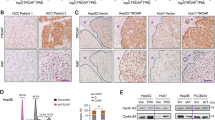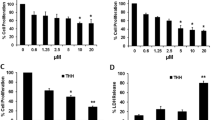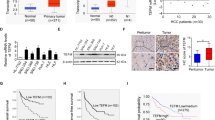Abstract
Mesenchymal epithelial transition factor (MET) is one of the critical cell signaling molecules whose aberrant expression is reported in several human cancers. The aim of the study is to investigate the antigene and antiproliferative effect of short triplex forming oligonucleotides, TFO-1 (part of the positive regulatory element) and TFO-2 (away from the transcription start site) on MET expression. HepG2 cells transfected only with TFO-1 (but not with TFO-2 and non-specific TFO) significantly decreased MET levels, which is accompanied by decrease in antiapoptotic proteins and increase in pro-apoptotic proteins. Phosphoproteome-array analysis of 46 intracellular kinases revealed hypophosphorylation of about 15 kinases including ERK, AKT, Src and MEK, suggesting the growth inhibitory effect of TFO-1. Further, the efficacy of TFO-1 was tested on diethylnitrosamine-induced liver tumors in wistar rats. T2-weighted magnetic resonance imaging showed decrease in liver tumor volume up to 90% after treatment with TFO-1. Decreased MET expression and elevated apoptotic activity further indicate that TFO-1 targeted to c-met leads to cell death and tumor regression in hepatoma. Formation of stable DNA triplex between TFO-1 and targeted gene sequence was confirmed by circular dichroic spectroscopy and gel retardation assay. Therefore, it can be concluded that DNA triplex-based therapeutic approaches hold promise in the treatment of malignancies associated with MET overexpression.
This is a preview of subscription content, access via your institution
Access options
Subscribe to this journal
Receive 12 print issues and online access
$259.00 per year
only $21.58 per issue
Buy this article
- Purchase on Springer Link
- Instant access to full article PDF
Prices may be subject to local taxes which are calculated during checkout







Similar content being viewed by others
References
Cooper CS, Park M, Blair DG, Tainsky MA, Huebner K, Croce CM et al. Molecular cloning of a new transforming gene from a chemically transformed human cell line. Nature 1984; 311: 29–33.
Weidner KM, Sachs M, Birchmeier W . The Met receptor tyrosine kinase transduces motility, proliferation, and morphogenic signals of scatter factor/hepatocyte growth factor in epithelial cells. J Cell Biol 1993; 121: 145–154.
Jiang WG, Martin TA, Parr C, Davies G, Matsumoto K, Nakamura T . Hepatocyte growth factor, its receptor, and their potential value in cancer therapies. Crit Rev Oncol Hematol 2005; 53: 35–69.
Varnholt H, Asayama Y, Aishima S, Taguchi K, Sugimachi K, Tsuneyoshi M . C-met and hepatocyte growth factor expression in combined hepatocellular and cholangiocarcinoma. Oncol Rep 2002; 9: 35–41.
Nakazawa K, Dobashi Y, Suzuki S, Fujii H, Takeda Y, Ooi A . Amplification and overexpression of c-erbB-2, epidermal growth factor receptor, and c-met in biliary tract cancers. J Pathol 2005; 206: 356–365.
Engelman JA, Zejnullahu K, Mitsudomi T, Song Y, Hyland C, Park JO et al. MET amplification leads to gefitinib resistance in lung cancer by activating ERBB3 signaling. Science 2007; 316: 1039–1043.
Ferracini R, Di Renzo MF, Scotlandi K, Baldini N, Olivero M, Lollini P et al. The Met/HGF receptor is over-expressed in human osteosarcomas and is activated by either a paracrine or an autocrine circuit. Oncogene 1995; 10: 739–749.
Tuck AB, Park M, Sterns EE, Boag A, Elliott BE . Coexpression of hepatocyte growth factor and receptor (Met) in human breast carcinoma. Am J Pathol 1996; 148: 225–232.
Schmidt L, Duh FM, Chen F, Kishida T, Glenn G, Choyke P et al. Germline and somatic mutations in the tyrosine kinase domain of the MET proto-oncogene in papillary renal carcinomas. Nat Genet 1997; 16: 68–73.
Lee JH, Han SU, Cho H, Jennings B, Gerrard B, Dean M et al. A novel germ line juxtamembrane Met mutation in human gastric cancer. Oncogene 2000; 19: 4947–4953.
Ma WW, Adjei AA . Novel agents on the horizon for cancer therapy. CA Cancer J Clin 2009; 59: 111–137.
Eder JP, Vande Woude GF, Boerner SA, LoRusso PM . Novel therapeutic inhibitors of the c-Met signaling pathway in cancer. Clin Cancer Res 2009; 15: 2207–2214.
Puri N, Khramtsov A, Ahmed S, Hetzel JT, Jagadeeswaran R, Karczmar G et al. A selective small molecule inhibitor of MET, PHA665752, inhibits tumorigenicity and angiogenesis in mouse lung cancer xenografts. Cancer Res 2007; 67: 3529–3534.
Morotti A, Mila S, Accornero P, Tagliabue E, Ponzetto C . K252a inhibits the oncogenic properties of Met, the HGF receptor. Oncogene 2002; 21: 4885–4893.
Berthou S, Aebersold DM, Schmidt LS, Stroka D, Heigl C, Streit B et al. The Met kinase inhibitor SU11274 exhibits a selective inhibition pattern toward different receptor mutated variants. Oncogene 2004; 23: 5387–5393.
Christensen JG, Zou HY, Arango ME, Li Q, Lee JH, McDonnell SR et al. Cytoreductive antitumor activity of PF-2341066, a novel inhibitor of anaplastic lymphoma kinase and MET, in experimental models of anaplastic large-cell lymphoma. Mol Cancer Ther 2007; 6: 3314–3322.
Petrelli A, Circosta P, Granziero L, Mazzone M, Pisacane A, Fenoglio S et al. Ab-induced ectodomain shedding mediates hepatocyte growth factor receptor down-regulation and hampers biological activity. Proc Natl Acad Sci USA 2006; 103: 5090–5095.
Kaji M, Yonemura Y, Harada S, Liu X, Terada I, Yamamoto H . Participation of c-met in the progression of human gastric cancers: anti-c-met oligonucleotides inhibit proliferation or invasiveness of gastric cancer cells. Cancer Gene Ther 1996; 3: 393–404.
Stabile LP, Lyker JS, Huang L, Siegfried JM . Inhibition of human non-small cell lung tumors by a c-Met antisense/U6 expression plasmid strategy. Gene Ther 2005; 11: 325–335.
Corso S, Migliore C, Ghiso E, De Rosa G, Comoglio PM, Giordano S . Silencing the MET oncogene leads to regression of experimental tumors and metastasis. Oncogene 2008; 27: 684–693.
McGuffie EM, Pacheco D, Carbone GM, Catapano CV . Antigene and antiproliferative effects of a c-myc-targeting phosphorothioate triple helix-forming oligonucleotide in human leukemia cells. Cancer Res 2000; 60: 3790–3799.
Cogoi S, Ballico M, Bonora GM, Xodo LE . Antiproliferative activity of a triplex-forming oligonucleotide recognizing a Ki-ras polypurine/polypyrimidine motif correlates with protein binding. Cancer Gene Ther 2004; 11: 465–476.
Shen C, Rattat D, Buck A, Mehrke G, Polat B, Ribbert H . Targeting bcl-2 by triplex-forming oligonucleotide—a promising carrier for gene-radiotherapy. Cancer Biother Radiopharm 2003; 18: 17–26.
Ebbinghaus SW, Gee JE, Rodu B, Mayfield CA, Sanders G, Miller DM . Triplex formation inhibits HER-2/neu transcription in vitro. J Clin Invest 1993; 92: 2433–2439.
Singhal G, Rajeswari MR . Interaction of actinomycin D with promoter element of c-met and its inhibitory effect on the expression of MET. J Biomol Struct Dyn 2009; 26: 625–636.
Varnholt H, Asayama Y, Aishima S, Taguchi K, Sugimachi K, Tsuneyoshi M . C-met and hepatocyte growth factor expression in combined hepatocellular and cholangiocarcinoma. Oncol Rep 2002; 9: 35–41.
Sambrook J, Fritch EF, Maniatis T . Molecular Cloning: A Laboratory Manual, 2nd edn. Cold Spring Harbour Press: NY, 1989.
Jain A, Rajeswari MR, Ahmed F . Formation and thermodynamic stability of intermolecular (R*R*Y) DNA triplex in GAA/TTC repeats associated with Freidreich's ataxia. J Biomol Struct Dyn 2002; 19: 691–699.
Liu Y . The human hepatocyte growth factor receptor gene: complete structural organization and promoter characterization. Gene 1998; 215: 159–169.
Liu Y, Tolbert EM, Sun AM, Dworkin LD . Primary structure of rat HGF receptor and induced expression in glomerular mesangial cells. Am J Physiol 1996; 271: F679–F688.
Chan PP, Glazer PM . Triplex DNA: fundamentals, advances, and potential applications for gene therapy. J Mol Med 1997; 75: 267–282.
Rajeswari MR, Bose HS, Kukreti S, Gupta A, Chauhan VS, Roy KB . Binding of oligopeptides to d-AGATCTAGATCT and d-AAGCTTAAGCTT: can tryptophan intercalate in DNA hairpins? Biochemistry 1992; 31: 6237–6241.
Lutterbach B, Zeng Q, Davis LJ, Hatch H, Hang G, Kohl NE et al. Lung cancer cell lines harboring MET gene amplification are dependent on Met for growth and survival. Cancer Res 2007; 67: 2081–2088.
Fan S, Wang JA, Yuan RQ, Rockwell S, Andres J, Zlatapolskiy A et al. Scatter factor protects epithelial and carcinoma cells against apoptosis induced by DNA-damaging agents. Oncogene 1998; 17: 131–141.
Mitry RR, Sarraf CE, Havlik R, Habib NA . Detection of adenovirus and initiation of apoptosis in hepatocellular carcinoma cells after Ad-p53 treatment. Hepatology 2000; 31: 885–889.
Xu GW, Sun ZT, Forrester K, Wang XW, Coursen J, Harris CC . Tissue-specific growth suppression and chemosensitivity promotion in human hepatocellular carcinoma cells by retroviral-mediated transfer of the wild-type p53 gene. Hepatology 1996; 24: 1264–1268.
Koritschoner NP, Bocco JL, Panzetta-Dutari GM, Dumur CI, Flury A, Patrito LC . A novel human zinc finger protein that interacts with the core promoter element of a TATA box-less gene. J Biol Chem 1997; 272: 9573–9580.
Rajeswari MR, Jain A, Sharma A, Singh D, Jagannathan NR, Sharma U et al. Evaluation of skin tumors by magnetic resonance imaging. Lab Invest 2003; 83: 1279–1283.
Peemoeller H, Shenoy RK, Pintar MM, Kydon DW, Inch WR . Improved characterization of healthy and malignant tissue by NMR line-shape relaxation correlations. Biophys J 1982; 38: 271–276.
Herynk MH, Stoeltzing O, Reinmuth N, Parikh NU, Abounader R, Laterra J et al. Down-regulation of c-Met inhibits growth in the liver of human colorectal carcinoma cells. Cancer Res 2003; 63: 2990–2996.
Druker BJ, Talpaz M, Resta DJ, Peng B, Buchdunger E, Ford JM et al. Efficacy and safety of a specific inhibitor of the BCR-ABL tyrosine kinase in chronic myeloid leukemia. N Engl J Med 2001; 344: 1031–1037.
Felsher DW, Bishop JM . Reversible tumorogenesis by MYC in hematopoietic lineages. Mol Cell 1999; 4: 199–207.
Patanè S, Avnet S, Coltella N, Costa B, Sponza S, Olivero M et al. MET overexpression turns human primary osteoblasts into osteosarcomas. Cancer Res 2006; 66: 4750–4757.
Taulli R, Accornero P, Follenzi A, Mangano T, Morotti A, Scuoppo C et al. RNAi technology and lentiviral delivery as a powerful tool to suppress Tpr-Met-mediated tumorigenesis. Cancer Gene Ther 2005; 12: 456–463.
Acknowledgements
We sincerely thank Yale Liver Centre, Yale University, USA for providing HepG2 cells. We also would like to thank Dr Ashutosh Haldar, Department of Reproductive Biology, A.I.I.M.S. for allowing us to use Fluorescence Microscope and Electron Microscopy Facility, A.I.I.M.S. for the help in acquiring TEM images. This work is funded by the Department of Science and Technology, India (Ref No: SR/SO/HS-118/2008). We wish to thank Professor Sudha Bhattacharya, Dean, School of Environmental Sciences, Jawaharlal Nehru University, India for providing us γ-32P [ATP] and Professor Shyamal K Goswami, School of Life Sciences, Jawaharlal Nehru University, India for allowing us to carry out the gel retardation assay using radioactive material.
Author information
Authors and Affiliations
Corresponding author
Ethics declarations
Competing interests
The authors declare no conflict of interest.
Rights and permissions
About this article
Cite this article
Singhal, G., Akhter, M., Stern, D. et al. DNA triplex-mediated inhibition of MET leads to cell death and tumor regression in hepatoma. Cancer Gene Ther 18, 520–530 (2011). https://doi.org/10.1038/cgt.2011.21
Received:
Revised:
Accepted:
Published:
Issue Date:
DOI: https://doi.org/10.1038/cgt.2011.21



